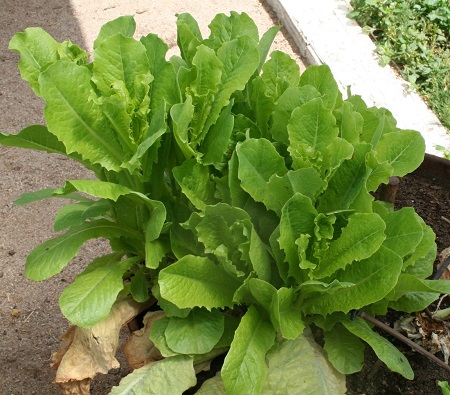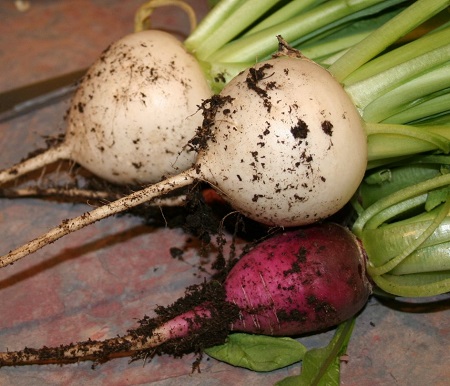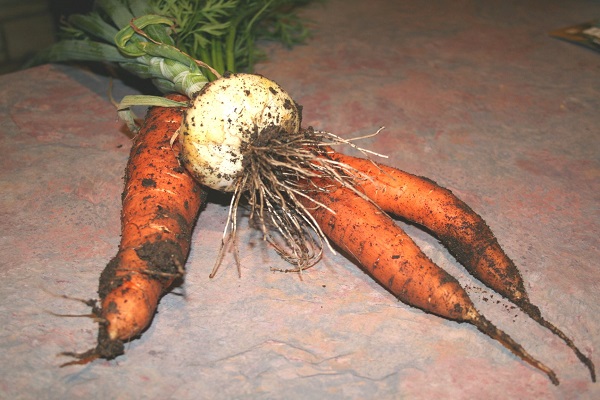If you’ve never thought about growing vegetables in the early spring and late fall, or harvesting well into the winter, then this is a good time to get acquainted with vegetable types that will help you do just that. It takes more than simply selecting the right vegetables, but it’s the right place to start. If you add a little protection, cut way back on the water, and harvest properly, you can make fresh vegetables a reality even after a couple months of winter weather.

Many of us are familiar with the flavor and texture of cold hardy crops, but few have ever considered their strengths when it comes to resisting frost and below freezing temperatures. Let’s simply review the characteristics of some of these cold harvest wonders that can allow us to stretch our vegetable gardening at both ends, regardless of where we live.
Among the more common varieties of cold hardy vegetables is lettuce. We often think of lettuce as a spring crop, and sometimes as a fall crop, but it’s hardy enough to make it into early winter with good results.
Lettuce is a bit deceiving as it appears to be quite delicate and not something that one would expect to be cold hardy. Nevertheless, with double protection from wind and cold, it can offer you quite a surprise when it comes to its resilience. I’ve had lettuce seedlings survive nighttime temperatures down as low as 9 degrees F. That’s chilly to say the least. By getting my seedlings out in early spring, I’m able to harvest fresh lettuce right about the time that most people are starting to sow seeds.

As you might expect, turnips are another cold hardy crop that we can count on to provide us with good cool and cold weather performance. Often, my turnips will do just fine with protection from the wind – think cold frame or row cover as a simple and easy form of protection. With double protection, you can expect turnips to go well below freezing and still provide an acceptable meal in the form of fresh slices or as an addition to soups and stews.
It’s also largely predictable that carrots would make this introductory list of cold hardy vegetables. With most if not all this root crop under the soil, there is a good chance that your carrots won’t even notice the first frosts of the season. Maintaining good quality from carrots late into winter will require protection in the form of a row cover or mulch, but it’s well worth it to get good fresh carrots throughout the winter months.

Like other root crops, carrots do nicely when left in the ground. Think of the cool soil much like a life-size refrigerator, holding your vegetables until you’re ready to pull or dig them out. It’s a good alternative to storage in the cellar. It’s especially nice if you’re using a garden tunnel or unheated greenhouse as these gardening structures will help keep you out of the winter wind and snow while you retrieve some of your investments from the summer.
Many of the Asian vegetables are also cold hardy. It almost seems like a contradiction to me since I often associate climates in Asia with warmth and humidity. Perhaps that’s because I’ve never spent a winter in Seoul. Be that as it may, many of the Asian vegetables are good performers in cold weather. I have harvested bok choi in the winter after it had reached minus 15 F overnight. I waited until it warmed up inside the greenhouse on the afternoon of the following day, and that ensured a successful harvest.
To be clear, my surviving bok choi looked like it “took a hit” during the bitter cold nighttime temperatures, but it was very much suitable for a nice stir-fry that evening. I clearly remember having to harvest it by slicing across the surface of the soil as there was no hope of cutting it out at the root – the soil was frozen solid and was impenetrable.
There are many different types of onions, and most of them can withstand cold weather given a little protection. It’s possible to keep some in the ground and dig them during the winter like carrots. Some onions are “winter over” varieties that require a second season to fully develop. I recall accidentally wintering over a few sweet onions without protection, and in the spring the rototiller dug up perfectly good onions as I tilled my garden soil. By the looks of them, you’d never know that they had survived the bitter cold of a Wyoming winter.
Closely related to onions are leeks. They are some of the most cold hardy vegetables and can be used as onion substitutes in many recipes. One of the main differences between keeping onions and leeks throughout the winter is that onions can be pulled and cured for long term cool and dry storage, whereas leeks are better when fresh from the garden.
Collards are a popular dish in the south and they are likely to be a crop for springtime planting. Like many other spring crops, collards are good performers in the late fall and early winter as well. Grow your collards during the spring and summer, and you can keep harvesting into the colder months of the year with a little added protection.

No discussion of cold hardy vegetables would be complete without talking about kale and its tremendous ability to resist cold weather. In milder winter climates, kale can survive throughout the winter even with no added protection. In fact, kale takes on a better eating quality after a frost or two – it tends to become sweeter. If you would like to experiment with cold hardy vegetables, and you like greens, I suggest you start with kale.
So, there you have it, an introduction to just a few cool weather and cold tolerant vegetables that you might enjoy in your garden and on your table. You can plant some of these in the spring for an early and late season harvest, or you can plant them in mid-summer for a robust plant that will help carry you into the winter months with a fresh harvest.
Once you’re familiar with cultivars that are successful in cooler weather, you’ll want to become familiar with techniques for watering, protection and harvesting. Knowing how to approach these aspects of cold weather vegetable gardening will help ensure your success.
Clair Schwan is an experienced vegetable gardener with open sun gardening beds and three quality greenhouses of his own design and construction. He grows over 100 varieties of vegetables and provides fresh produce year-round for himself and his family.
Related Articles & Free Email Newsletter Sign Up
How to Grow Effectively in a Greenhouse Year-Round
How to Maximize Your Vegetable Yields
How to Rethink Your Vegetable Gardening for an Extended Season



Comment here